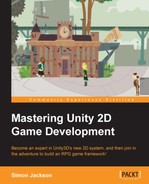Unity3D has long been viewed as a massive 3D game-making middleware system, with lots of power and an easy-to-use editor. Now, with 2D games back in fashion, Unity has created a 2D toolset for developers with the know-how to create great, customized games.
If you are looking for a book that will show you how to make a fully functional, customizable game product with popular game functionality, then this is the book for you. You will learn how to build an RPG game framework, learning lots of tips and tricks along the way, from advanced C# scripting to getting the most out of Unity's built-in features such as Mecanim and curves, but in ways you may have not even considered.
While creating your own character with its very own little village, you will come to learn about all the new 2D features and how to make the most out of them. Then, you will dive into the big wild world with your character, discovering how to manage different types of scenes, scripting random events, and the dreaded encountering of enemies. You will learn how to make your character ready for battles (with a little shopping) and engaging hordes of angry creatures just rumbling for a fight; how they react is completely up to you.
The one thing this title doesn't cover is audio, as this hasn't changed in Unity 4.3. With so much preparation for Unity 5, it's fair to say that big things are coming; however, there is more than enough to really sink your teeth into.
By the end of this book, you will be able to architect, create, deploy, and integrate your game with all of your intended platforms, and you'll also have the knowledge to build and customize the Unity editor and the games you create with confidence. You will also be schooled with tricks of the trade on marketing and monetization, as well as targeting as many platforms as possible, with a keen focus on how to best profit from your title.
No goblins were hurt during the production of this title; however, a few were extremely grumpy about their poor working conditions.
Chapter 1, Overview, starts with a look at what Unity has brought to the table from Version 4.2. In this chapter, we will have a walkthrough of the new 2D system and other new features.
Chapter 2, Building a Character, involves rolling up our sleeves as we dig in and start working with 2D assets and sprites, thereby uncovering the sprite editor and a host of other interesting features.
Chapter 3, Getting Animated, introduces that animation is a key in any 2D title; you need more than just a picture to tell a story, so we delve into the new and improved Unity animation system and dope sheet. Beware, curves ahead.
Chapter 4, The Game World, explains that with the basics in hand, we will build our home town and let our character run free within it.
Chapter 5, NPCs and Interactions, explains that an RPG game without people to talk to would be kind of dull. Here, we will build messaging and conversation systems, readying ourselves to leave the nest and venture beyond. Advanced coding, engage.
Chapter 6, The Big Wild World, widens the scope of what we can see, and discusses art and assets, building a map view for the player to navigate in. If you look closely, you can just about see your house from here.
Chapter 7, Encountering Enemies and Running Away, discusses that the world is a big and scary place; you stumble upon a crowd of goblins snacking on their latest meal (who knows what's in that pot), and then get scared and run away. Here, we go through building a battle scene, including setting up Mecanim as a state and AI machine.
Chapter 8, Shopping for Weapons, dives into lots of shiny things! Leveraging our 2D skills, we build a simple shop scene, reusing our messaging system to add interactivity and expand the player's structure adding an inventory. Plus, we look at the other graphical ways of displaying the player's inventory with a cool command bar implementation.
Chapter 9, Getting Ready to Fight, makes us ready to rumble! We have a battle scene but no battle engine yet. Now, it's time to expand on what we have created with a turn-based battle engine, flexing Mecanim's muscles in ways you probably haven't considered.
Chapter 10, The Battle Begins, depicts us opening fire (or at least the axe or sword we came with) on the unsuspecting goblins and shattering their tiny bodies with a gratuitous blood scene (PEGI rating pending). From here, it's up to you how you wish to proceed.
Chapter 11, Onward Wary Traveler, describes that we have a game framework—all it needs is content and some packaging. So, we'll look at what's involved in finishing your game. Not stopping there, we will look at how you can extend the editor to tame this wild beast to work for us and make it build our content for us (or at the very least, make it a whole lot easier).
Chapter 12, Deployment and Beyond, covers the time taken to tackle the last piece of the puzzle, putting your game on a device. We walk through what it means to be multiplatform and build a trustworthy save/load system that will work on multiple platforms, not just one. We finish with a handy marketing section, aimed to arm you and help make your final product successful in the marketplace.
Appendix, Additional Resources, has a heap of assets, links, and information resources to help you with your game building travels.
